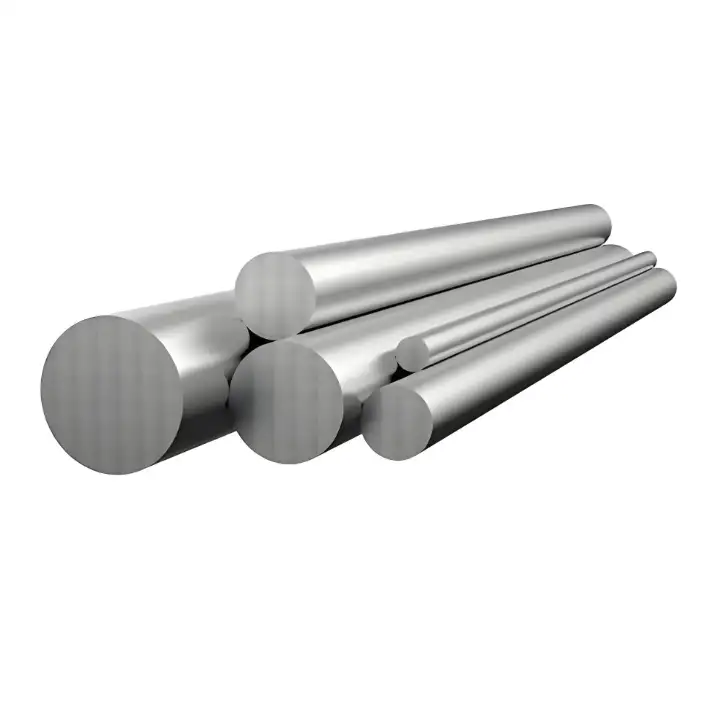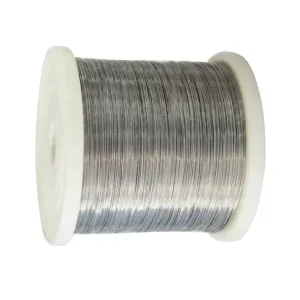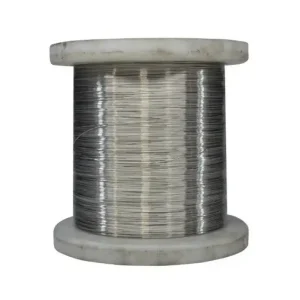Hastelloy C‑4 is a low‑carbon, nickel‑chromium‑molybdenum superalloy renowned for its microstructural stability and exceptional resistance to both oxidizing and reducing acids—including hydrochloric and sulfuric—while withstanding chloride‑induced pitting and crevice corrosion. We at MWalloys supply custom C‑4 in plates, bars, rods, coils, wire, pipes, and welding consumables, tailored for the most aggressive chemical processes.
What Is Alloy C‑4?
Alloy C‑4 (UNS N06455, EN 2.4610) is the most microstructurally stable of the common Ni–Cr–Mo materials, developed to resist “sensitization” in weld heat‑affected zones. It tolerates harsh chemical environments without grain‑boundary precipitates that lead to intergranular attack.
Hastelloy® Alloy C-4 (UNS N06455) Full Specifications & Parameters
| Category | Property | Value / Specification | Notes & Conditions |
|---|---|---|---|
| Chemical Composition | Nickel (Ni) | Balance (≥59%) | Primary constituent |
| Chromium (Cr) | 14.0–18.0% | Oxidation resistance | |
| Molybdenum (Mo) | 14.0–17.0% | Corrosion resistance in reducing media | |
| Iron (Fe) | ≤3.0% | Stabilizer | |
| Titanium (Ti) | ≤0.70% | Grain boundary stabilizer | |
| Carbon (C) | ≤0.015% | Low carbon minimizes sensitization | |
| Manganese (Mn) | ≤1.00% | ||
| Silicon (Si) | ≤0.08% | ||
| Cobalt (Co) | ≤2.0% | ||
| Sulfur (S) | ≤0.03% | ||
| Phosphorus (P) | ≤0.04% | ||
| Physical Properties | Density | 8.64–8.94 g/cm³ | |
| Melting Range | 1325–1380°C (2417–2516°F) | ||
| Thermal Conductivity | 10.1–11.4 W/m·K | At 100°C | |
| Coefficient of Thermal Expansion | 10.3–13.3 μm/m·°C | 20–100°C range | |
| Elastic Modulus | 210–211 GPa | At 20°C | |
| Electrical Resistivity | 1.24–1.25 μΩ·m | At 20°C | |
| Mechanical Properties | Tensile Strength (RT) | ≥690 MPa (min) | Annealed/solution-treated |
| Yield Strength (0.2% Offset, RT) | ≥275–310 MPa (min) | ||
| Elongation (RT) | ≥40% (min) | ||
| Hardness | ≤200 HB | Brinell; annealed state | |
| Thermal Properties | Continuous Service Limit | ≤400°C (752°F) | Long-term corrosion service |
| Short-Term Stability | 650–1040°C (1202–1904°F) | Resists embrittlement during aging | |
| Stress Rupture Strength (600°C) | ~40 MPa | For 1,000h | |
| Corrosion Resistance | Reducing Media (H₂SO₄, HCl, H₃PO₄) | Excellent (e.g., low corrosion in boiling 65% H₂SO₄) | |
| Oxidizing Media (HNO₃, mixed acids) | Good (resists nitric acid up to moderate concentrations) | ||
| Halides (Cl⁻, seawater, brine) | Exceptional (resists pitting, SCC, and crevice corrosion) | ||
| Organic Acids (CH₃COOH, acetic anhydride) | Superior | ||
| Fabrication | Hot Working | 1080–900°C (1976–1652°F), rapid quench | Followed by solution annealing |
| Solution Annealing | 1065–1200°C (1950–2190°F), rapid cool | Water/air quench | |
| Welding | GTAW/GMAW with ERNiCrMo-11 filler Low heat input (interpass ≤150°C) |
Pre-weld cleaning essential | |
| Machining | Challenging (use carbide tools; low speeds/high feeds) | High work-hardening rate | |
| International Standards | Bar/Rod | ASTM B574, ASME SB-574 | |
| Plate/Sheet/Strip | ASTM B575, ASME SB-575 | ||
| Seamless/Welded Tube | ASTM B619/B622/B626, ASME SB-619/SB-622/SB-626 | ||
| Forgings/Fittings | ASTM B564, ASME SB-564 | ||
| Applications | Chemical Processing | Reactors, heat exchangers, acid-regeneration plants | |
| Flue Gas Desulfurization (FGD) | Scrubbers, ducting, dampers | ||
| Electroplating/Pickling | Tanks, heaters, fixtures | ||
| Nuclear Fuel Reprocessing | Chlorination reactors, waste-handling systems |
🔑 Key Notes & Variability Sources
-
Compositional Limits:
-
Low C, Si, Fe, and absence of W are critical for thermal stability (650–1040°C) and resistance to sensitization.
-
Ti (≤0.7%) suppresses grain-boundary carbide precipitation in welded zones.
-
-
Property Discrepancies:
-
Density/Thermal Conductivity: Slight variations (8.64–8.94 g/cm³; 10.1–11.4 W/m·K) stem from processing methods and test temperatures.
-
Mechanical Strength: Minimum tensile/yield values are ASTM guarantees; typical industry reports show higher values (e.g., UTS up to 795 MPa).
-
-
Corrosion Performance Highlights:
-
Acid Blends: Uniquely resistant to HCl/HNO₃ mixtures and contaminated mineral acids due to balanced Cr/Mo.
-
Weld Integrity: Low C content prevents intergranular corrosion in as-welded conditions—critical for FGD systems.
-
-
Fabrication Constraints:
-
Heat Treatment: Avoid sulfur-bearing atmospheres (>0.1% S in fuel) to prevent embrittlement.
-
Thermal Exposure: Prolonged service above 400°C may reduce ductility; stress-relieve welds for >150°C applications.
-
💎 Summary: Hastelloy® C-4 excels in aggressive reducing/oxidizing environments (e.g., hot acids, chlorides) with unmatched thermal stability (≤1040°C). Its low-carbon Ni-Cr-Mo matrix ensures weldability without sensitization, making it indispensable for chemical, nuclear, and pollution-control equipment. For nuclear/aerospace grades, specify ASTM B574/B575 with supplementary testing.
Hastelloy C-4 Global Price Comparison (USD/kg & CNY/kg)
| Product Form | China | Europe | United States | India |
|---|---|---|---|---|
| Plate | $21.4–67.6 USD/kg ¥155–490 CNY/kg |
$38.6–44.8 USD/kg ¥280–325 CNY/kg |
$34.5–41.4 USD/kg ¥250–300 CNY/kg |
$20.7–27.6 USD/kg ¥150–200 CNY/kg |
| Bar/Rod | $24.3–39.9 USD/kg ¥176–289 CNY/kg |
$41.4–48.3 USD/kg ¥300–350 CNY/kg |
$37.9–44.8 USD/kg ¥275–325 CNY/kg |
$22.1–31.0 USD/kg ¥160–225 CNY/kg |
| Coil | $26.2–31.0 USD/kg ¥190–225 CNY/kg |
$44.8–51.7 USD/kg ¥325–375 CNY/kg |
$41.4–48.3 USD/kg ¥300–350 CNY/kg |
$24.8–34.5 USD/kg ¥180–250 CNY/kg |
| Wire | $29.0–34.5 USD/kg ¥210–250 CNY/kg |
$48.3–55.2 USD/kg ¥350–400 CNY/kg |
$44.8–51.7 USD/kg ¥325–375 CNY/kg |
$27.6–37.9 USD/kg ¥200–275 CNY/kg |
🔎 Key Observations & Market Drivers
-
Regional Price Tiers
-
Asia (China & India): Lowest prices due to competitive domestic production (e.g., Shanghai Yehu, Guoni Heavy Industry) and lower logistics costs.
-
Europe & U.S.: 40–60% premium driven by strict certifications (ASTM/ASME/AMS), import tariffs, and compliance costs.
-
-
Product-Form Premiums
-
Wire > Coil > Bar > Plate: Processing complexity increases costs (e.g., wire requires multi-stage cold drawing).
-
Coil: Higher than plate due to continuous rolling/surface treatment but lower than wire.
-
-
Volume Discounts
-
China: 5–10% discount for orders ≥100 kg (e.g., coil drops to ¥150/kg).
-
Europe/U.S.: Limited discounts (3–5% for >1 ton) due to fixed compliance overheads.
-
-
Regional Nuances
-
India: Prices may exceed listed ranges due to import dependency (reliant on Chinese intermediates).
-
Europe: German brands (W.Nr. 2.4610) command 8–12% premium for nuclear/aerospace specs.
-
Why Choose C‑4?
-
HAZ Stability: Resists grain‑boundary precipitates even after welding, reducing sensitization risk.
-
Acid Resistance: Outperforms Alloy C‑276 in hydrochloric and sulfuric environments.
-
High‑Temperature Service: Maintains mechanical integrity up to 1,038 °C (1,900 °F).
-
Versatility: Available in wrought, welded, and clad forms—for maximum design freedom.
Manufacturing & Forming Alloy C‑4
-
Hot Working: Forge or roll between 955–1,177 °C; avoid over‑heating to prevent grain growth.
-
Cold Working: Strengthens the alloy; follow with solution anneal at 1,066 °C (1,950 °F) for 10–30 min, then quench.
-
Welding: Compatible with ENiCrMo‑7 electrodes or ERNiCrMo‑7 wire; good weldability without post‑weld anneal.
-
Machinability: Moderate; use rigid tooling and moderate speeds to manage work‑hardening.
Comparison with Similar Alloys
Welding Practices
Use GTAW/GMAW with ENiCrMo‑7. Maintain interpass < 150 °C; no post‑weld annealing is needed for general service, though solution treat benefits extreme acid duties.
FAQS
1. Why is Hastelloy C‑4 considered microstructurally stable after welding?
Hastelloy C‑4 resists grain-boundary precipitation (like M₆C or sigma phases) even under high heat, making it safe for welding without fear of sensitization. This stability minimizes intergranular corrosion in the HAZ, a common issue for C‑276 and stainless steels.
2. What acids and corrosive environments can C‑4 withstand?
It remains resistant to both oxidizing and reducing acids—including hydrochloric, sulfuric, formic, and acetic—as well as chloride-containing atmospheres and seawater. Critical testing shows its corrosion resistance surpasses many Ni–Cr–Mo alloys.
3. Can Hastelloy C‑4 be used at high temperatures without degrading?
Yes. C‑4 retains structural stability and ductility up to ~1,038 °C (1,900 °F). It does not form detrimental intermetallic phases (like sigma or mu) even after prolonged exposure in the 649–1,038 °C range.
4. Is Hastelloy C‑4 susceptible to stress-corrosion cracking (SCC)?
No. Hastelloy C‑4 exhibits excellent resistance to chloride-induced SCC and is routinely specified for stress-corrosive environments where stainless steels would fail.
5. How should C‑4 be welded to ensure performance?
Recommended practices include using GTAW/GMAW with ERNiCrMo‑7 filler, maintaining low interpass temperatures (<150 °C), and ensuring cleanliness before welding. No post-weld annealing is generally necessary, thanks to its weld-stable microstructure.
6. What makes C‑4 machinable and formable?
While it work-hardens more quickly than stainless steel, C‑4 is still fairly machinable using rigid tooling and controlled speeds. Additionally, it can be hot forged (955–1,177 °C) or cold formed without losing corrosion resistance. When needed, solution annealing (1,066 °C, water-quenched) can be used to restore ductility.





